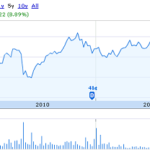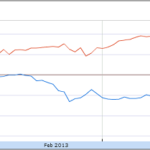With yields on 10-Year Treasuries dropping below 3% again on worries in the EU and another lousy jobs report, it’s worth noting that there are 10 stocks in the Dow Jones Industrial Average yielding over 3%. As compiled by CNBC this week, this table highlights 10 of the 30 stocks comprising the index with a current yield over 3%. You’ll recognize many of these names like AT&T (T), Pfizer (PFE) and General Electrics (GE) as household names. While some consider the DJIA to be somewhat out of date, the nature of the more established companies lends them to higher yields than your typical NASDAQ holding.
(click to enlarge)
Pros and Cons of High Yielding Dow Stocks
There has been much study on the performance of the highest yielding Dow stocks (usually termed “Dogs of the Dow”). In one respect, since the Dow Industrials tend to be venerable, established companies capable of sustaining their dividend payouts, investors assume that the current dividend payout will remain intact for the foreseeable future. However, by consistently buying the stocks with the highest yields, you’re often buying the recent worst performers (hence, the high yield due to lower share prices) which means you might be buying shares in a downtrend. It’s an interesting concept, but history hasn’t shown that these Dogs really perform any better than the index as a whole. And furthermore, some investors tend to favor the dividend strategy of buying stocks increasing dividend payouts over current high yield stocks.
There is an exchange traded note Dogs of the Dow ETN (DOD). By looking at performance of DOD versus the DJIA since DOD’s inception in late 2007, the performance is a virtual perfect match, which begs the question as to whether the expense ratio is worth pursuing the strategy. Given the meteoric rise in equities since 2009, conservative income investors might just be better off chasing safe high yield investments and settling for lower returns until interest rates rise again.
Disclosure:Â No position in any stocks referenced in this article.













{ 0 comments… add one now }
{ 2 trackbacks }